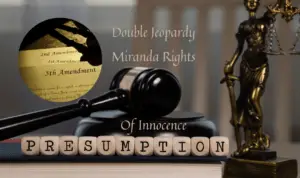The definition of Continuing Crime: Continued Crime or Delito Continuado is defined as “a single crime consisting of a series of acts but all arising from one criminal resolution”. Hence, although series of acts are committed, it only constitutes one crime because it is in pursuance of a single criminal impulse and only one penalty shall be imposed upon the offender.
On the other hand, continuing offense or also known as “transitory crimes” or “moving crimes” is defined as “a continuous, unlawful act or series of acts set foot by a single impulse and operated by an unintermittent force, however long time it may occupy.
This is considered continuing offense because some acts or any of the essential ingredients to the crime and other elements of their commission occur in one municipality or place and some acts are committed in another. It can also be consummated in one place but by the nature of the offense, the violation is deemed continuing.
This is used in criminal procedure to determine venue and denote that a criminal action for this crime may be instituted and tried not only in the court of the municipality or province where it was originally committed but also before the court of the place where the crime was continued and where any of its essential ingredients took place.
Continuing Crime Example
Continued crime is illustrated in the case of People v. De Leon, wherein one of the issues involved is whether or not the accused, with intent to gain on the same occasion and in the same place, took the roosters belonging to Magat and Nicolas constitutes two crimes of theft.
The Supreme Court held that “the act of taking the two roosters, in response to the unity of thought in the criminal purpose on one occasion, is not susceptible of being modified by the accidental circumstance that the article unlawfully belonged to two distinct persons. There is no series of acts here for the accomplishment of different purposes, but only one of which was consummated, and which determines the existence of only one crime. The act of taking the roosters in the same place and on the same occasion cannot give rise to two crimes having an independent existence of their own, because there are not two distinct appropriations nor two intentions that characterize two separate crimes” (People v. De Leon, G.R. Nos. L-25375 and 25376, October 8, 1926).
The accused, in taking possession of the roosters did not commit only a single act of taking but by two separate acts. However, it is evident that there is a unity of action and thought in taking the two roosters.
Continuing Offense Example
Conversely, to explain the concept of Transitory Crimes or Continuing Offense, jurisprudence on the matter provides that acts essential to the crime which include deceitful manipulation and false pretense and the damage which were consummated in different places constitute a continuing offense.
Thus, the Supreme Court held that, “the circumstance that the deceitful manipulations or false pretenses employed by the accused as shown in the vouchers, might have been perpetrated in Quezon City does not preclude the institution of the criminal action in Mandaluyong where the damage was consummated. Deceit and damage are the basic elements of estafa. The estafa involved in this case appears to be a transitory or continuing offense. It could be filed either in Quezon City or Rizal. The theory is that a person charged with a transitory offense may be tried in any jurisdiction where the offense is in part committed” (Tuzon v. the Honorable Cesar C. Cruz, G.R. No. L-27410, August 28, 1975).
In another case which involves evasion of service, the appellant, who was then serving a life sentence in penitentiary in Muntinlupa was transferred to Fort Bonifacio which was then known as Makati, Rizal when the President of the Philippines commuted his sentence to twenty years escaped the prison and was recaptured in the City of Manila.
Thus, it was held that, “there are however, crimes which although all elements thereof for its consummation may have occurred in a single place, yet by reason of the very nature of the offense committed, the violation of the law is deemed to be continuing. To this latter class may also be included the crime of evasion of sentence, when the prisoner in his attempt to evade the service of the sentence imposed upon him by the courts and thus defeat the purpose of the law, moves from one place to another; for, in this case, the act of the escaped prisoner is a continuous series of acts, set foot by a single impulse and operated by an unintermittent force, however long it may be. It may not be validly said that after the convict shall have escaped from the place of his confinement the crime is fully consummated, form as long as he continues to evade the service of his sentence, he is deemed to continue committing the crime” (Parulan v. Director of Prisons, February 17, 1968).
To put it succinctly, in Continued crime (Continuing Crime) or Delito Continuado, the offender commits a series of acts at the same place and the same time, having one criminal purpose and violating the same penal provision; whereas in Transitory crime, the essential elements of the crime was committed in different places or if not, in cases where its consummation occurred in a single place, the violation of the law due to the nature of the offense is deemed to be continuing.
Effect of Single Criminal Resolution in connection with Continuing Crimes
In the law, there is plurality of crimes (concurso de delitos) when the actor commits various crimes of the same or different kind. There is ideal plurality (concurso ideal) which occurs when a single act gives rise to various infractions of law. Real plurality (concurso real), on the other hand, arises when the accused performs an act or different acts with distinct purposes and resulting in different crimes which are juridically independent. In comparison from this plurality of crimes is a continuous crime (delito continuado) which is a single crime consisting of a series of acts arising from a single criminal resolution or intent not susceptible of division.
When an act or acts complained of resulted from a single criminal impulse, it is usually held to constitute a single offense to be punished with a 0enalty corresponding to the most serious crime, also imposed in its maximum period. There must be singularity of the criminal act or singularity of criminal impulse, as the Court held in People v. Pineda. The two or more acts should be of unity with its criminal intent or purpose which led to the commission of the same criminal purpose or aim. The crimes committed must be of different and of independent existence on its own.
As discussed in People v. Pineda, the abstractions were not made at the same time and on the same occasion, but on variable dates. Each day of conversion constitutes a single act with an independent existence and criminal intent of its own. All the conversions are not the product of a consolidated or united criminal resolution, because each conversion is a complete act by itself. Specifically, the abstractions and the accompanying deposits thereof in the personal accounts of private respondent cannot be similarly viewed as “continuous crime”.
But when the acts are wholly different, not only to themselves, but also because they were directed against two different persons, as when one fires his revolver twice in succession, killing one person and wounding another, or when two persons are killed one after the other, by different acts, although these killings were the result of a single criminal impulse, the different acts must be considered distinct crimes.
In People v. Lawas, the Court stated that the assault was executed under one single impulse, resulting in the wounding of two victims, which constituted a complex crime. Hence, for the objective of attaining one single purpose that constitutes an offense, various acts are executed so such acts must he considered as only one offense which is a complex one. Further, various acts committed under one criminal impulse may constitute one single complex offense (People v. Pincalin).
Aggravating Circumstance: Felony Committed by a Band
Article 14 of the Revised Penal Code, paragraph 6, provides for the aggravating circumstance of a crime committed in the nighttime or in an uninhabited place, or by a band, whenever such circumstances may facilitate the commission of the offense. The aforementioned provision of the same Code also explains that whenever more than three armed malefactors acted together in the commission of an offense, it shall be deemed to have been committed by a band.
The provision is explicit that a band is defined as more than three armed men acting together in the commission of the crime. The band must be composed of more than three armed persons with everyone having the same knowledge of the commission of a crime. It is important to note that even when there are fifteen or more people acting together but only two of them are armed, it cannot be considered as a band.
These persons, who are more than three, should also be armed or has a weapon in their possession while committing the crime. All the armed men, at least four in number, must take direct participation in the execution of the crime. This aggravating circumstance is based on the means and ways employed in the commission of the crime.
The aggravating circumstance of “by a band” is considered in crimes against property and crimes against persons, but not in crimes against chastity.
To illustrate, here’s an example when the aggravating circumstance “by a band” is considered:
At about 10:00 in the evening, A and B were walking along Malate, Manila, when suddenly, C shot B, hitting him in the leg. A tried to help his friend, B, but D, E, and F, arrived all with pistol in their hands and surrounded A and B. When A tried to call for help and B tried to reach his phone, C, D, E, and F, relentlessly shot both of them. Unsatisfied with their shooting and to conclude the crime, C, D, E, and F, kicked A and B on their faces, then, again C fired at both victims. Of course, as a result, both A and B died. C, D, E, and F are now charged with homicide. Will the aggravating circumstance of “by a band” be appreciated in this case?
Without prejudice to the appreciation other qualifying circumstances, the aggravating circumstance of “by a band” may otherwise be considered in this case. The killing was committed by four malefactors, all armed with a pistol. The four perpetrators acted together in inflicting death on both A and B, all with weapons in their hands as they mercilessly shot at the their victims.




